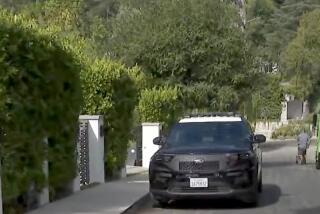Chipping Away at the Castle Walls
If our homes are our castles, lots of folks in this town probably would love to install moats.
For a while now, communities have been walling off the world, with barriers physical or psychological, in search of peace of mind, status or higher property values.
That’s certainly the case in the San Fernando Valley, the Balkan Peninsula of Greater Los Angeles.
Some Canoga Park residents renamed their neighborhood West Hills a few years ago, inspiring North Hills--which is neither north nor particularly hilly--to secede from Sepulveda this year.
Councilman Hal Bernson last week even lobbied the postmaster general-- in person-- to remove some Valley neighborhoods from Sepulveda’s ZIP code (too low on the prestige scale) and thus create a new identity.
And some Van Nuys residents want their neighborhood declared part of Sherman Oaks. At least they’re not asking for Sherman Hills.
So what a relief it was to run across the Valley 2000 Council, a grass-roots organization bent on tearing down walls and building what council members call a “sense of community” there.
A tough goal, to bridge the divides separating plain Van Nuys and plush Encino, distressed Pacoima and decorous Woodland Hills.
And, not surprisingly, the Valley 2000 Council, sponsored by a coalition of 250 churches called the Valley Interfaith Council, learned that the walls don’t come down easily. Here’s what happened:
Eighty volunteers culled from civic groups and churches were divided into six subgroups that met for five consecutive Tuesday nights in June and July to discuss urban problems--the homeless, interracial relations, health care, environment, education. The subgroups met in volunteers’ homes, the hosts providing cake, cookies and coffee.
The aim was not to find solutions to urban ills, but to discuss them and, in the process, learn the viewpoints of other Valley residents and share expertise. To use the obnoxious business term, they were networking.
There were some rough spots. Some guest speakers canceled at the last minute. One Jewish man, offended when someone criticized U.S. aid to Israel, dropped out of the program. One woman sparred with a guest speaker over who had the floor. She dropped out too.
But when the volunteers said their goodbys on their last night together, many spoke like old friends and parted with the sadness of kids having to go home after summer camp. Humor had enlivened some meetings. But others, because they focused on intractable problems, gave way to sadness.
During a discussion on the homeless, Sylvia Zimring of Studio City wondered why the country appears unable to shelter people as it did in earlier troubling times. Even when Dust Bowl refugees flooded California in her girlhood, “somehow we took care of them.”
“I don’t know,” she went on. “I think we’ve lost some compassion.” For a moment, the group sat silently in agreement.
A week earlier, while discussing interracial relations, Zimring’s husband, Martin, told of a neighbor who complained that he can’t understand new immigrants who speak with accents. “It’s getting so different here I think I’m going to go back to Tennessee,” the neighbor had said.
The group members sighed and shook their heads. “He finds it difficult to adjust to all these changes,” Martin Zimring said.
The groups here were trying to adjust to the shifting racial balances of the Valley. But the groups themselves did not reflect those shifts. They were mostly white, largely female, middle-class and middle-aged.
Even group members complained about such ethnic conformity in a program aimed at embracing ethnic diversity. One woman called her group as homogenous as yogurt.
Anita Kremen, coordinator of the program, said she had tried to attract minorities and young adults to the home meetings but found little interest. “We are living in an intense atmosphere of alienation and apathy,” she said.
Perhaps. But maybe some people saw little sense in the format--talk, talk and talk. Perhaps the program was poorly publicized. Perhaps some wanted to attend but, lacking the middle-class luxury of free time, could not. Perhaps none of the above.
Was it worth it? Despite the shortcomings, yes.
Building a community is not like building an artificial reef; you don’t just toss old tires into the bay. The 80 volunteers knew that, but they attended their meetings nonetheless, and their leaders plan more meetings in the future.
If nothing else, they tried to chip away at those hostile castle walls. So few do.
More to Read
Sign up for Essential California
The most important California stories and recommendations in your inbox every morning.
You may occasionally receive promotional content from the Los Angeles Times.










